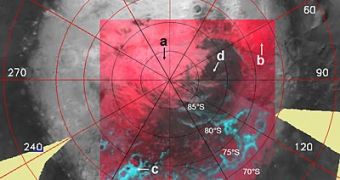Mars' cryptic region is an area near the planet's South Pole which becomes much darker than the nearby regions during the southern spring. Scientists are intrigued about how could this area be in the polar region and not be covered in bright ice. The region was discovered in the 1970s by the orbiter missions around Mars and its mystery deepened in the 1990s when new observations showed that the temperature was so low (around -135 degrees Celsius) that carbon dioxide ice had to be present.
Scientists have thought that maybe the entire region - region d in this photo - is covered in a sheet of transparent carbon dioxide ice about one meter thick, allowing the dark surface underneath to be seen. But now, new observations made by Mars Express's OMEGA instrument show that this cannot be so.
The transparent carbon dioxide ice would be opaque to certain infrared wavelengths. "We see only weak absorptions in the infrared, which would indicate little carbon dioxide ice in the cryptic region," said Yves Langevin, Institut d'Astrophysique Spatiale, Orsay, France, who led the analysis of the OMEGA results.
The OMEGA instrument measures both the visible and the infrared light reflected by the planet's surface. By analyzing the spectrum of this reflected light, scientists can deduce the chemical composition of the surface. This is possible because various minerals and ices absorb and reflect different wavelengths of light, so each is characterized by a certain optical "fingerprint".
So, what makes the cryptic region dark? The only solution seems to be that the region is covered by ice and the ice is covered by dust. But how did the dust get there? And why aren't the other regions covered with dust as well?
This mosaic image was built from ten photos taken from an altitude of about 6000 kilometers over the South Pole during the Martian early to mid-Spring. The letters indicate regions with different surface compositions and texture (a: bright, fine-grained "dry ice"; b: larger grained "dry ice" which is not quite as bright; c: water ice frost; d: cryptic region). The red color indicates the presence of carbon dioxide and the bluish regions indicate the presence of water ice.
Langevin thinks that some markings dotting the cryptic region, first discovered by NASA's Mars Global Surveyor in 1998-1999, could offer a solution to the mystery. The markings are known as 'spots', 'spiders' or 'fans' depending upon their particular shapes.
It seems that these markings are caused by solar heating of the soil underneath the ice. As the soil heats up the carbon dioxide near the surface melts and then boils. Eventually the gas bubble beneath the ice explodes like a geyser throwing parts of the soil above the ice. Langevin thinks this process might be sufficient to explain the cryptic region.
"In terms of physics, this is a straightforward process and would go a long way towards explaining our observations," he said.
However, at this point, one might only wonder why is it that the other regions nearby don't experience the same thing. More information about this would be obtained during the next southern spring equinox on Mars, in 2007. Langevin and other astronomers are curious to take a closer look to the region just before the spring equinox to see how the region looks before the sunlight heats up the region too much.

 14 DAY TRIAL //
14 DAY TRIAL //